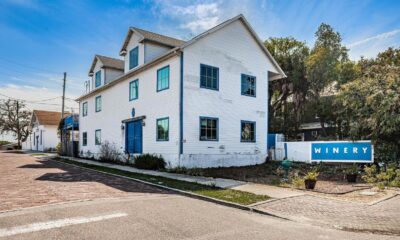Create
Vintage St. Pete: The Operetta and the Music Circus

When professional musical theater made its grand entrance in St. Petersburg, it wasn’t with major-league stars, first class sound and lights and Broadway-style creature comforts like air conditioning and cushioned seats.
In January, 1951, what St. Petersburg got was a canvas, big top-style tent in a vacant lot, with a 43-foot ceiling and 1,400 hard wooden chairs set on staggered platforms directed at the circular stage, at ground level in the center of the tent.

In the tent: Ronnie Cunningham and Erik Rhodes in “The Firefly,” 1951.
Still, the arrival of the St. Petersburg Operetta was big news; the actors, actresses, singers and dancers were stage veterans, from New York and around the country, and the productions themselves – light musicals like The Student Prince, The Vagabond King and Naughty Marietta – were well-tuned crowd-pleasers and performed with a live orchestra (set in a pit dug lower than the floor).
Since nothing much ever happened in St. Petersburg, the local papers treated the Operetta debut like a visit from the Royal Family.
 The venture’s P.T. Barnum-like central character was Pennsylvanian public relations man, short story writer and wannabe impresario Pat Hurley, who convinced four Philadelphia businessmen to invest $50,000 each to fund the St. Petersburg Operetta. Drugstore magnate William Sylk had two sons enrolled at Admiral Farragut Academy here. Financier Jay Cooke had been stationed in Florida during World War II (he had also unsuccessfully run for governor of Pennsylvania, with Hurley as his campaign manager).
The venture’s P.T. Barnum-like central character was Pennsylvanian public relations man, short story writer and wannabe impresario Pat Hurley, who convinced four Philadelphia businessmen to invest $50,000 each to fund the St. Petersburg Operetta. Drugstore magnate William Sylk had two sons enrolled at Admiral Farragut Academy here. Financier Jay Cooke had been stationed in Florida during World War II (he had also unsuccessfully run for governor of Pennsylvania, with Hurley as his campaign manager).
The idea – and it seemed like a darn good one – was to bring the professionals to Florida for 13 weeks in the winter. A variation on summer stock – a repertory company that would stay in the same place for a while, performing a rotating season of shows.
Bring some culture to the folks out in the boondocks. And stay warm in the bargain!
Hurley had a real horse in the race in his business partner Wilbur Evans, a theater and radio veteran with a booming baritone voice and a dashing, likable-rascal stage persona. Evans would star in most of each season’s 12 planned shows, and direct them all.
Soprano and “prima donna” Victoria Sherry’s husband Roland Fiore – a talented composer and conductor from New York City Center Opera – was hired as Musical Director.

In the tent: MacCaulay, Rhodes and Rosemarie Brancato in “The Firefly,” 1951.
Tented theater-in-the-round was something of a national craze at the time. The style was pioneered by showman St. John (aka Sinjin) Terrell in post-war New Jersey; his Lambertville Music Circus was an immediate success and spawned copycats across the country.
Terrell himself was busy spreading his brand; in 1950 he opened a Music Circus in Miami, and for reasons unknown chose tiny, undeveloped Treasure Island as the company’s “sister” city.
One of Terrell’s business partners was producer Robert Aldrich, husband of British stage star Gertrude Lawrence. She and Aldrich were part owners of a Terrell tent stage in Hyannis, Massachusetts.
Hurley and Terrell must have kept tabs on one another, although there’s no record of either of them complaining about – or even mentioning – the competition.
Located in a circus tent at the intersection of Gulf Boulevard and the Treasure Island Causeway, the Treasure Island Music Circus debuted Jan. 9, 1951 with Song of Norway.
Six days later and 18 miles away, the St. Petersburg Operetta opened its first production, The Merry Widow.
The battle for theatrical supremacy was on.
 In the end, it wasn’t much of a battle. Attendance was low out at the T.I. tent – halfway through the second week’s show, No No Nanette, the decision was made to pull the plug and send the company back to Miami (among the cast was a young “hopeful” named Elaine Stritch; the teenaged assistant stage director was Larry Hagman, son of actual Broadway icon Mary Martin and the future I Dream of Jeannie and Dallas TV star).
In the end, it wasn’t much of a battle. Attendance was low out at the T.I. tent – halfway through the second week’s show, No No Nanette, the decision was made to pull the plug and send the company back to Miami (among the cast was a young “hopeful” named Elaine Stritch; the teenaged assistant stage director was Larry Hagman, son of actual Broadway icon Mary Martin and the future I Dream of Jeannie and Dallas TV star).
After Carousel took its final bows Jan. 28, the Treasure Island Music Circus folded its tent.
“This is just not the place for us,” manager Arthur Gerold told the St. Petersburg Times. “Our productions are very high class and expensive … if we lowered the quality, it would not be the Music Circus. Your town does not seem to be able to afford this type of entertainment, judging from our audiences, and it would not pay us to continue.”

Souvenir photos from “The Merry Widow”: Clockwise from left Sherry, Rotov, MacCaulay and Burris.
Sherry had the lead role in the Operetta production of The Merry Widow, with Evans – who also directed – as her leading man. The cast also included handsome tenor Glenn Burris, towering character actor Joseph MacCauley and 4-foot-9 “satirical” dancer Alex Ritov. “Rotov is so tiny the children who pack matinees adore him as an animated Charlie McCarthy,” howled the Times. “And their parents shriek with laughter at his ballet satires.”
These five would be the core of the Operetta company for its first 13-week season, although others would come and go as needed.
Theatre-in-the-round is much more demanding than Broadway shows. I was in Up in Central Park for 22 months – it was nothing compared to this. While we’re doing one show, we’re learning another. Thus a lead must learn five or six songs, 35-40 pages of dialogue per week. So that a principal has perhaps 10 different songs buzzing around in his head, to say nothing of 80 or 90 lines.
Wilbur Evans, St. Petersburg Times, March 25, 1951
Week after week, it was a cold winter. “The modern thermostatic oil heating plant keeps the canvas operadome at comfortable levels,” declared the Times, but playgoers complained anyway about the chills, and about the uncomfortable seats, and about the difficulty in understanding the dialogue from the faraway circular stage.
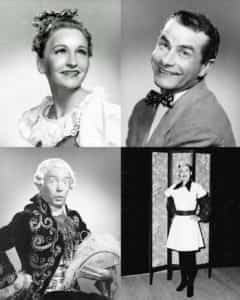
Clockwise from top left: Doris McKee, Jack Goode, Ruth Webb and John MaCaulay (both in costume for “The Vagabond King”).
On April 2, with just two performances left for The Great Waltz, the final show of the year, high winds blew the Operetta tent over. Evans, Sherry, McCaulay and the rest of the cast ended their inaugural season in the St. Petersburg High School auditorium.
The destruction of the tent was just one factor in Hurley’s decision to move the Operetta into a permanent location, with real walls and a real roof and not so far from downtown. A race track, Tri-City Speedway, had been proposed for the neighborhood. Loud, constant noise was something the Operetta most definitely did not need.
He brokered a deal with the owners of Gay Blades Roller Rink, 2191 9th Avenue North, to house the next five Operetta seasons there. The price tag for a 13-week lease of the pseudo-Quonset Hut was $15,000.
(This was before Gay Blades was taken over by the Gould family, who made a three-decade success out of the recreation facility.)
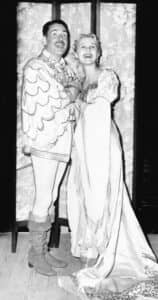
Wilbur Evans and Victoria Sherry in “The Vagabond King,” performed under the tent during the St. Petersburg Operetta’s first season, 1951.
The second season began on Jan. 2, 1952, with the (non-air conditioned) roller rink temporarily fitted out with a central stage and the same angled wooden platforms and rows of seats. The capacity, again, was 1,400.
Missing in action was perennial leading man Wilbur Evans, who’d opened in the fall in South Pacific, opposite Mary Martin, on London’s West End. Evans never returned to St. Petersburg.
The cast of financial backers changed, too, as Hurley’s First Four stayed home in Pennsylvania. The new money men – all local – included contractor W.C. Gorman and realtor D.D. Rosselli.
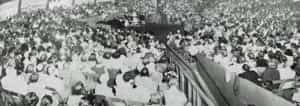
Operetta seating in the roller rink
The business became The Operetta Corporation, and the investors announced an intention to make money, rather than lose it as Hurley had done in his “tent season.”
Victoria Sherry remained as the company’s main female lead, with husband Fiore staying aboard as well. The shows included Brigadoon, Carousel, Sally, The Merry Widow (again), The Red Mill and similarly frothy fare.
In March, Hurley boasted to a Times reporter that the Operetta was operating squarely in the black, and that plans were being finalized to open a second location in Tampa, rotating the same shows and casts. He also said he was negotiating to bring the enterprise to Orlando, Jacksonville, Atlanta and New Orleans.
None of which ever happened.
Hurley reported outstanding attendance figures for each of the shows, averaging more than 10,000 guests for each production’s seven-week run in the made-over roller palace.
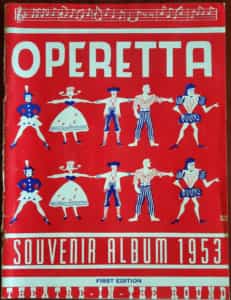 When Season Three began in January, 1953, only Sherry, Fiore and dancer Rotov remained from the original company.
When Season Three began in January, 1953, only Sherry, Fiore and dancer Rotov remained from the original company.
Stephen Douglass, who’d played Billy Bigelow in the Broadway production of Carousel, and launched the role in the West End, assayed it again for the Operetta’s season-opener. Others performing in Season Three included Joan Kibrig, Van Hawley (who would go on to co-star in the horror film The Manster), John Shanks, Colee Worth, Hawaiian singer/actor Dick Smart, Margaret Irving, Earle MacVeigh and (returning from the second season) Rosemarie Brancato and Stanley Carlson.
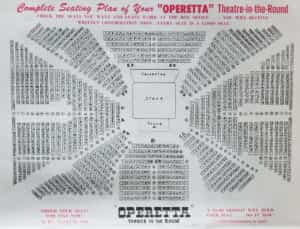
Seating chart for the Gay Blades location.
Choreographer Jamie Jamieson, who arranged the hotfoot hoofing for The Wizard of Oz, Kiss Me Kate, High Button Shoes and the rest of the third season’s crowd-pleasers, later went on to work with Agnes DeMille on numerous revivals of Brigadoon, and became one of the best-known Scottish Highland performers in the dance world.
The plot thickened considerably in February when on the Board of Directors voted to fire Hurley, catching the Operetta’s founder and producer – so he claimed – completely by surprise.
Gorman and Rosselli said that they and the other directors felt that Hurley had not given his best to the Operetta and that it was that they believed he had not fulfilled his duties that his contract had been abrogated … “We are parting with Hurley for what we hope are for the best interests of the community,” Gorman said. “We want to do everything we can for this city.”
St. Petersburg Times, Feb. 13, 1953
From there, the end came swiftly. On May 10, it was announced that The Operetta Corporation and the owners of Gay Blades Roller Rink could not reach an agreement on a lease extension. Gay Blades co-owner Bill Bryan offered to host a 1954 season for a reduced rate of $12,000; Gorman and company suggested $8,000, and a small percentage of the profits.
And Bryan told them to stuff it.
Ticket sales for a post-Hurley fourth season began in the summer, although the shows had not been finalized and a new location had yet to be secured.
An aircraft hangar at Albert Whitted Field was considered, but ruled out, as was another big-top tent south of downtown. Both St. Petersburg Junior College and Boca Ciega High School turned down auditorium lease requests.
In late January, refunds were mailed in the form of checks signed by Operetta President Donald Rosselli. An accompanying letter read, in part: “Being unable to secure a site, the producer was forced to abandon his plan for 1954. The chances are excellent that an operetta season will be held in 1955.”
Rosselli said he had “no idea” how many checks had been issued but explained he had signed a “slew.” He said he had “no comment whatsoever” to make in connection with the refunds or announcement of the Operetta failure.
St. Petersburg Times, January 26, 1954
And with that last scene, the curtain fell on Act One of professional musical theater in St. Petersburg.
This story appears in the book Vintage St. Pete – The Golden Age of Tourism – and More (St. Petersburg Press).

One more from “The Firefly.”




